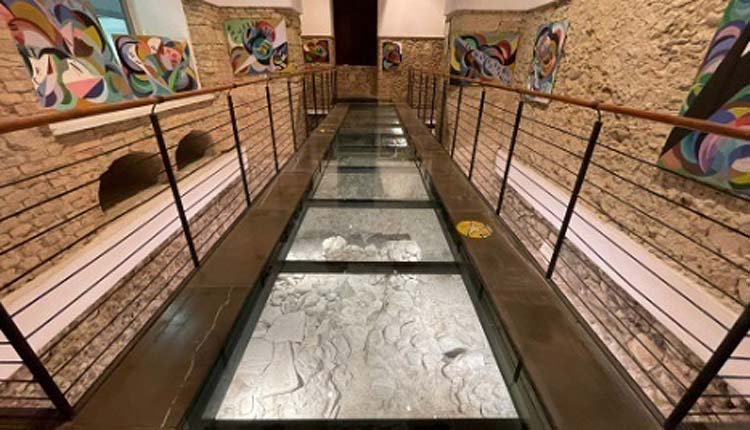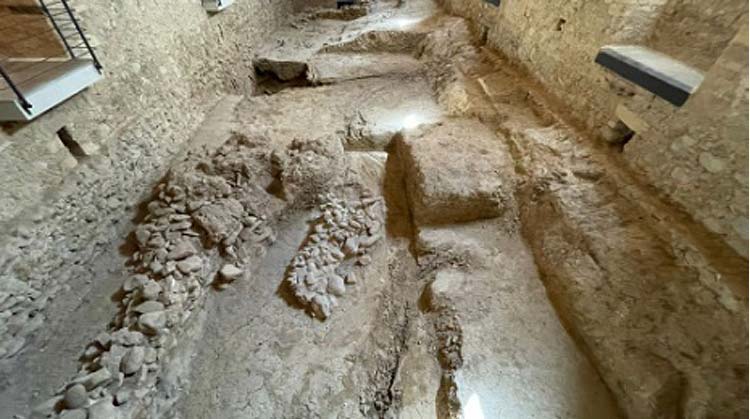There are not many libraries that can boast a true archaeological itinerary within them, important enough to shape a museum: however, this is what happens at the National Library of Cosenza, which is not only the custodian of a substantial book heritage, but also of the ancient historical memory of the city. Indeed, the Calabrian city has been the subject of archaeological excavations for decades: research began shortly after the Unification of Italy, and, although to a lesser extent than literary and epigraphic sources (e.g., the mentions of Cosenza that appear in the works of Livy, Strabo and Appian, or, as far as epigraphy is concerned, the important tombstone of Polla, also known as the elogium of Polla, a slab dated 2nd century B.C., found not far from Cosenza, in the locality of San Pietro di Polla, and believed to be an important document for understanding the Romanization of the Italic territories), have helped to give us an idea of how life was lived in Roman Consentia and how much theancient Cosenza, at least from the 4th century B.C. onward, was one of the nerve centers of the area, first as the capital of the Bruzi(or Brettii), a people of Italic stock who inhabited present-day Calabria since the Iron Age and who made themselves independent of the Lucanians in 356 B.C.C., and then as one of the most important Roman cities in the region, a significant colony in the years of Augustus.
The most important excavations, however, are those conducted between the 1980s and the 1990s, underneath some buildings in Cosenza’s historic center: the Soprintendenza per i Beni Archeologici della Calabria, in conducting a number of urban archaeological interventions throughout that two decades, collected material useful for understanding how Cosenza’s urban planning evolved in the crucial years of its ancient history, showing, moreover, how the stratifications also concern the following centuries, bearing witness to an urban center that has remained alive over time. If the first important data on the topography of the ancient city date back to 1984, it was between 1988 and 1990, it was with the excavations of the old Episcopal Seminary, a building constructed in the late nineteenth and early twentieth centuries that is now home to the National Library, that what the library itself calls an “important example of a convergence of intentions between institutions of the Public Administration (peripheral organs of the Ministry of Cultural Heritage and Activities) in the area of protection and enhancement of cultural property that becomes the usable heritage of the community.”
In fact, from the study of what was hidden underneath the National Library building, it was possible to broaden the knowledge of previous investigations (such as those conducted on Palazzo Pompeo Sersale, an aristocratic building built beginning in 1592), arriving at a broad understanding of the conformation of ancient Cosenza, with the result that it was possible to reconstruct a map of the city quite different from that which had emerged from the investigations of the early 20th century. It was precisely thanks to the study of the stratifications of the Seminary that it was possible to ascertain that the city of the Bruzi, from the 4th century B.C. until many centuries later, already extended along the entire slope that descends from the Pancrazio Hill toward the left bank of the Crati River, thus covering an area corresponding to that of the present historic center of Cosenza.
 The
The The archaeological
The archaeologicalThe museum of the National Library of Cosenza is a journey within this history that starts with the Brettians, passes through the Romans and reaches the present day. The Brettians were, as mentioned, an ancient Italic people who were first subjugated to the Lucanians, and then became autonomous from them in 356 B.C.: they lived mainly on agriculture and pastoralism, but soon also specialized in manufacturing and trade with neighboring peoples. The development of Cosenza was due precisely to the centrality that the city had in their territory (close to the Ionian Sea, at the beginning of the fertile valley of the Crati, and along the routes between the north and south of Calabria), and to the dominant position on the Pancrazio hill that allowed, in case of eventualities, to guarantee the best defenses. The city did not lose importance even after the Bruzi were defeated by the Romans in 202 B.C., sanctioning Rome’s domination of the region: in fact, the Roman Consentia overlapped with the “metropolis” (i.e., the main political and commercial center) of the Brettians, remaining a relevant center of communication. The museum tour set up in the National Library of Cosenza allows visitors to travel through part of the ancient city.
In particular, in the north wing and southwest wing of the old Episcopal Seminary, under the floor levels, during some consolidation works, remains of dwellings of the Consentia of theRomans were discovered, with also evidence of life at that time: today it is all visible in the museum route of the National Library of Cosenza. For example, in compartment 11, a skeleton of an adult bovine was found in the rubble of a cobblestone wall, which was killed by the collapse of the wall itself, but which was attempted to be recovered (in fact, traces of slaughter were found). And then, excavation four meters below the floor level of the inner courtyard of the former Seminary, in Room 14, returned evidence of at least three phases of occupation of the site on which the Library now stands: in fact, the remains of an ancient dwelling with dry river pebble plinth interspersed with limestone blocks and pieces of tiles were found here, which was used without interruption from the time of the Brettians, that is, from the fourth century B.C.C., until the height of the Roman imperial age, that is, until the 2nd century AD. The area was then obliterated by a thick layer of clay soil on which the foundations of the Bishop’s Seminary were set.
In nearby room 12, on the other hand, it is possible to find evidence of a calamitous event, most likely an earthquake, which resulted in the collapse of a flat tile and pantile roof covering three rooms of a Hellenistic house (from the late 3rd or early 2nd century BCE.C.) that remained in use until the collapse of the roof, an event datable to the 2nd century A.D. on the basis that three vents, certainly referable to that era, were found crushed during the collapse.
The route between the excavations of the former Bishop’s Seminary (an example of archaeological investigation on an urban scale, aimed not only at increasing specialized knowledge, but also at the recovery and enhancement of significant portions of the historic center), is now available to the public, after several restoration and securing works have made possible theopening of these premises, where it is possible to read a book or attend a book presentation or meeting (here in fact is the conference room, which periodically hosts exhibitions and events) right above the vestiges of the Cosenza of more than two thousand years ago.
 The
The The archaeological
The archaeologicalThe National Library of Cosenza is housed in the former Episcopal Seminary, the construction of which was begun in 1882, when there was an urgent need to abandon the old seventeenth-century seminary as it no longer met the needs of the diocese. An imposing building, conceived and built by Canon Raffaele Parise, parish priest of the Cathedral and rector of the Institute, it was finished in 1905, near the old building, which was integrated with the new one so as to accommodate up to 120 pupils in the new rooms. During World War II, the older part of the seminary complex was completely destroyed by bombing, which miraculously spared the newer part of the complex instead. As a result of the Seminary’s decline and rising maintenance costs, the building was sold: it was taken over by the Ministry of Cultural Heritage and Activities, which restored and renovated it to make it, since 1985, the home of the National Library of Cosenza, established in 1978.
Among the main funds of the National Library of Cosenza are the Amantea Fund, consisting of some 3,000 volumes of a specifically historical-literary nature illustrating the culture and society of the 20th century, the Bedarida fonto (belonging to Professor Henri Bedarida, lecturer at the University of the Sorbonne, consisting of both book materials and manuscripts, e.g. personal correspondence and with publishing houses, reviews, discussions, theses, working papers), the D’Apolito Fund, a bibliographic collection of works of the nineteenth and twentieth centuries, literary-artistic in character, the Gaudio Fund with works of a historical-legal character, the fund of the heirs of the musicians Stanislao and Giuseppe Giacomantonio who donated to the National Library of Cosenza all the works, mostly manuscript, documents and autograph papers, as well as some personal items of these two musicians (father and son) who play a remarkable role in 20th-century Italian music. Then there is also the ancient fund that belonged to the Pellicano Castagna family and was donated to the library in 1993, of literary, historical, and religious character, with works of particular value such as Torquato Tasso’s Gerusalemme liberata of 1611 and Camillo Camilli’s 5 cantos of the same year, to end with the fund including the works composed by maestro Giuseppe Scalzo, mostly intended for band performance, consisting of more than 4,500 papers and including sonatas, symphonies, military marches
symphonic and funeral works, light and folk music.

Warning: the translation into English of the original Italian article was created using automatic tools. We undertake to review all articles, but we do not guarantee the total absence of inaccuracies in the translation due to the program. You can find the original by clicking on the ITA button. If you find any mistake,please contact us.